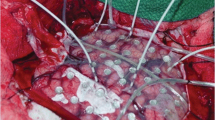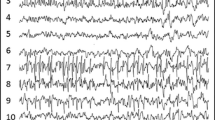Abstract
Purpose
Focal cortical dysplasia (FCD) is the most frequent etiology for drug-resistant epilepsy in young children. Complete removal of the lesion is mandatory to cure the epilepsy. Stereo-EEG (SEEG) is an excellent method to delimitate the zone to be resected in older children and adults. We studied its feasibility in younger children.
Methods
We retrospectively studied 19 children under 5 years of age who underwent SEEG between January 2009 and December 2012 and were subsequently operated on. FCD was diagnosed in all. We reviewed magnetic resonance imaging (MRI), electrophysiological and clinical data, as well as postoperative seizure outcome. We also included fluoro-deoxyglucose positron emission tomography (FDG-PET) studies, which had been systematically performed before invasive recording in 16 of the 19 children.
Results
The mean patient’s age at the time of SEEG was 38.6 months, and the mean age at seizure onset was 8 months. Three patients had normal MRI. No SEEG-associated complications occurred. We were able to delineate the epileptogenic zone in all children, and electrode stimulation localized the motor area when necessary (12 patients). Hypometabolic areas on FDG-PET included the epileptogenic zone in 13 of the 16 children, with a lobar concordance in 9 (56 %) and the same anatomical extent in 6 (38 %). Twelve children subsequently underwent focal or sublobar resection, six had multilobar resection, and one had hemispherotomy. The etiology was FCD type 2 in 15 and FCD type 1 or type 3 in three children. Eighty-four percent of our population have remained seizure-free at a mean follow-up of 29 months (12–48 months).
Conclusion
Although children with FCD can successfully undergo resective surgery without invasive EEG, poor seizure semiology at this age inclines to perform SEEG when the dysplastic lesion is ill-defined and/or the electroclinical correlation is unclear. In cases with normal imaging as well as with suspected huge malformations, as was the case in 52 % of our patients, we consider it to be indispensable.




Similar content being viewed by others
References
Bancaud J (1980) Surgery of epilepsy based on stereotactic investigations—the plan of the SEEG investigation. Acta Neurochir 30(Suppl):25–34
Barkovich AJ (2000) Concepts of myelin and myelination in neuroradiology. Am J Neuroradiol 21:1099–1109
Blauwblomme T, Ternier J, Romero C et al (2011) Adverse events occurring during invasive electroencephalogram recordings in children. Neurosurgery 69(Operative suppl 2):169–175
Blümcke I, Thom M, Aronica E et al (2011) The clinicopathologic spectrum of focal cortical dysplasias: a consensus classification proposed by an ad hoc Task Force of the ILAE Diagnostic Methods Commission. Epilepsia 52:158–174
Chassoux F, Devaux B, Landré E et al (2000) Stereoelectroencephalography in focal cortical dysplasia: a 3D approach to delineating the dysplastic cortex. Brain 123:1733–1751
Chassoux F, Rodrigo S, Semah F et al (2010) FDG-PET improves surgical outcome in negative MRI Taylor-type focal cortical dysplasias. Neurology 75:2168–2175
Chassoux F, Landré E, Mellerio C et al (2012) Type II focal cortical dysplasia: electroclinical phenotype and surgical outcome related to imaging. Epilepsia 53:349–358
Cossu M, Cardinale F, Colombo N et al (2005) Stereoelectroencephalography in the presurgical evaluation of children with drug-resistant focal epilepsy. J Neurosurg 103(Suppl 4):333–343
Engel JJ et al (1993) Outcome with respect to epileptic seizures. In: Engel JJ (ed) Surgical treatment of the epilepsies. Raven, New York, pp 609–621
Harvey Cross JH, Shinnar S et al (2008) Defining the spectrum of international practice in pediatric epilepsy surgery patients. Epilepsia 49:146–155
Hauptman JS, Mathern GW (2012) Surgical treatment of epilepsy associated with cortical dysplasia: 2012 update. Epilepsia 53(suppl 4):98–104
Krsek P, Pieper T, Karlmeier A et al (2009) Different presurgical characteristics and seizure outcomes in children with focal cortical dysplasia type I or II. Epilepsia 50:125–137
Lee SK, Kim DW (2013) Focal cortical dysplasia and epilepsy surgery. J Epilepsy Res 3:43–47
Otsuki T, Honda R, Takahashi A et al (2013) Surgical management of cortical dysplasia in infancy and early childhood. Brain Dev 35:802–809
Rowland NC, Englot DJ, Cage TA et al (2012) A meta-analysis of predictors of seizure freedom in the surgical management of focal cortical dysplasia. J Neurosurg 116:1035–1041
Rubi S, Setoain X, Donaire A et al (2011) Validation of FDG-PET/MRI coregistration in nonlesional refractory childhood epilepsy. Epilepsia 52:2216–2224
Salamon N, Kug J, Shaw SJ et al (2008) FDG-PET/MRI coregistration improves detection of cortical dysplasia in patients with epilepsy. Neurology 71:1594–1601
Tassi L, Colombo N, Garbelli R et al (2002) Focal cortical dysplasia: neuropathological subtypes, EEG, neuroimaging and surgical outcome. Brain 125:1719–1732
Taussig D, Dorfmüller G, Fohlen M et al (2012) Invasive explorations in children younger than 3 years. Seizure 21:631–638
Acknowledgments
We are indebted to EEG technologists Mss. M. Benghezal and I. Cheramy. We thank the physicians who referred the patients to epilepsy surgery.
Conflict of interest
None of the authors have any conflicts of interest to disclose.
We confirm that we have read the journal's position on issues involved in ethical publication and affirm that this report is consistent with those guidelines.
Author information
Authors and Affiliations
Corresponding author
Rights and permissions
About this article
Cite this article
Dorfmüller, G., Ferrand-Sorbets, S., Fohlen, M. et al. Outcome of surgery in children with focal cortical dysplasia younger than 5 years explored by stereo-electroencephalography. Childs Nerv Syst 30, 1875–1883 (2014). https://doi.org/10.1007/s00381-014-2464-x
Received:
Accepted:
Published:
Issue Date:
DOI: https://doi.org/10.1007/s00381-014-2464-x




